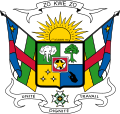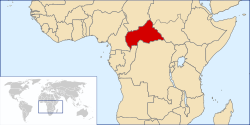Portal:Central African Republic
The Central African Republic Portal
The Central African Republic (CAR) is a landlocked country in Central Africa. It is bordered by Chad to the north, Sudan to the northeast, South Sudan to the east, the Democratic Republic of the Congo to the south, the Republic of the Congo to the southwest, and Cameroon to the west. Bangui is the country's capital and largest city, bordering the Democratic Republic of the Congo. The Central African Republic covers a land area of about 620,000 square kilometres (240,000 sq mi). As of 2024, it has a population of 5,357,744, consisting of about 80 ethnic groups, and is in the scene of a civil war, which has been ongoing since 2012. Having been a French colony under the name Ubangi-Shari, French is the official language, with Sango, a Ngbandi-based creole language, as the national and co-official language. The Central African Republic mainly consists of Sudano-Guinean savanna, but the country also includes a Sahelo-Sudanian zone in the north and an equatorial forest zone in the south. Two-thirds of the country is within the Ubangi River basin (which flows into the Congo), while the remaining third lies in the basin of the Chari, which flows into Lake Chad. What is today the Central African Republic has been inhabited since at least 8000 BCE. The country's borders were established by France, which began annexing portions to the French Congo in the late 19th century and in 1903 established the separate colony of Ubangi-Shari, part of French Equatorial Africa. After gaining independence from France in 1960, the Central African Republic was ruled by a series of autocratic leaders, including under Jean-Bedel Bokassa who changed the country's name to the Central African Empire and ruled as a monarch from 1976 to 1979. The Central African Republic Bush War began in 2004 and, despite a peace treaty in 2007 and another in 2011, civil war resumed in 2012. The civil war perpetuated the country's poor human rights record: it was characterized by widespread and increasing abuses by various participating armed groups. Despite its significant mineral deposits and other resources, such as uranium reserves, crude oil, gold, diamonds, cobalt, lumber, and hydropower, as well as significant quantities of arable land, the Central African Republic is among the ten poorest countries in the world, with the lowest GDP per capita at purchasing power parity in the world as of 2017. As of 2023, according to the Human Development Index (HDI), the country had the third-lowest level of human development, ranking 191 out of 193 countries. The country had the second lowest inequality-adjusted Human Development Index (IHDI), ranking 164th out of 165 countries. The Central African Republic is also estimated to be the unhealthiest country as well as the worst country to be in for young people. The Central African Republic is a member of the United Nations, the African Union, the Economic Community of Central African States, the Organisation internationale de la Francophonie and the Non-Aligned Movement. (Full article...) Selected article -Bangassou is a city in the southeastern of Central African Republic, lying on the north bank of the Mbomou River. It has a population of 24,447 (2003 census) and is the capital of the Mbomou prefecture. It is known for its wildlife, market, and nearby Bangassou Airport and is linked by ferry to the Democratic Republic of Congo on the south bank. The city is also home to the Roman Catholic Diocese of Bangassou. Axmin Mining Camp and Kembé Falls are located in the area. (Full article...) General images -The following are images from various Central African Republic-related articles on Wikipedia.
MapDid you know (auto-generated)Entries here consist of Featured articles and Good articles, which consist of high-quality content on English Wikipedia..
Bangui (French pronunciation: [bɑ̃ɡi]; or Bangî in Sango, formerly written Bangi in English) is the capital and largest city of the Central African Republic. It was established as a French outpost in 1889 and named after its location on the northern bank of the Ubangi River (French: Oubangui); the Ubangi itself was named from the Bobangi word for the "rapids" located beside the settlement, which marked the end of navigable water north from Brazzaville. The majority of the population of the Central African Republic lives in the western parts of the country, in Bangui and the surrounding area. The city has been part of Bangui Prefecture since December 2020. As of 2020[update] it had an estimated population of 889,231. (Full article...) CategoriesWikiProjectsRelated portalsCities
* not the capital of the prefecture
TopicsAssociated WikimediaThe following Wikimedia Foundation sister projects provide more on this subject:
Discover Wikipedia using portals | ||||||||||||||||||||||||||||||||||||||||||||||||||||||||||||||||





























































